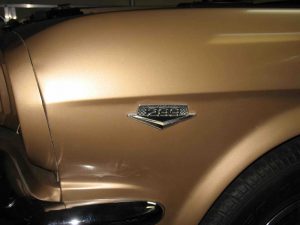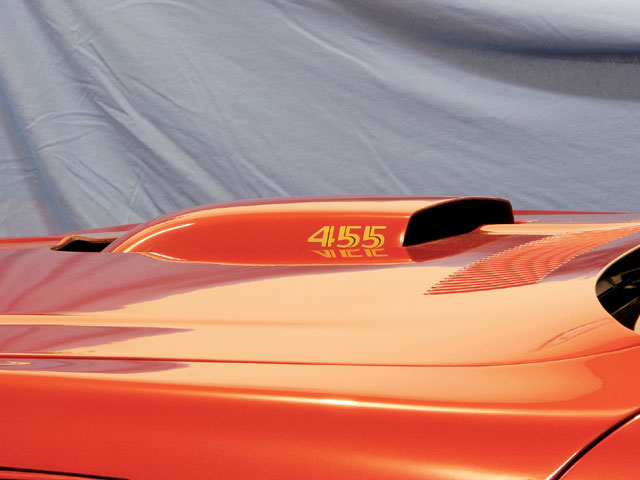Little things sometimes have a lot of significance.
One of those things happened the year after my ’76 Trans-Am was built. The next year, 1977, the decals affixed to either side of the Trans-Am’s iconic “shaker” hood scoop – so named because the scoop was attached to the engine and poked through the hood; it shook with the left-right movement of the engine on its mounts when the driver goosed the throttle – were metricized.
Instead of “400” or “455” – denoting either the standard 400 cubic inch V8 or the optional 455 cubic inch V8 that were available in ’76 – in ’77 you could pick either the standard 6.6 litre (sic) 400 or the optional (higher-performance) “T/A 6.6” litre 400.
Italics added.
But no more mention of the 400 – or the cubic inches.
In one fell swoop, one of the most iconic American cars had been subtly used as a vehicle to normalize an un-American way of identifying engines in that it was the European/Japanese way of identifying them, via liters.
This is no small thing – because it was a key step in the process of homogenizing of cars, via their engines – which are no longer referred to affectionately (and almost personally) by their numbers, as once they were.
No one sings about their 2.0 liter four. There were hit songs sung about 409 big block Chevys and 389 Pontiacs.
One of the great joys of raising the hood of an American car – back when American cars were American cars – was seeing an American engine, frequently a V8. These often had names, such as the Oldsmobile Rocket (350 and 455) and the 440 (Mopar) Commando or the 340 Wedge. Early Mustang GTs proudly boasted – in bright chrome lettering on each front fender – the 289 that powered them.
This began to change in the mid-late ’70s as American cars became more like European cars and today American cars are – with a few exceptions – indistinguishable from European (and Japanese) cars. Most look like they came from the same lozenge factory.
It wasn’t an accidental much less natural evolution.
Traditionally American cars were gradually but systematically pushed off the road by forcing them to be (and so, look) more like European and Japanese cars. Meaning, smaller – and smaller engined. This was done via federal regulations that favored the smaller – and smaller – engined cars that European and Japanese car manufacturers specialized in. Japanese small cars were especially favored by the regulations that rewarded the manufacture of the smaller – and smaller engined – cars the Japanese initially specialized in almost exclusively. They didn’t make large (or large-engined) cars and were thus greatly advantaged by the regulations that punished the making of them. This isn’t to say the Japanese cars weren’t good; many were excellent.
The fact is the regs favored imported cars over American cars – and served to push American car companies to make their cars more like imported cars, such that today there is very little meaningful distinction between imported and American (especially since many “import” brand cars are made here, in America – and many “American” cars are made not-in-America).
One of the last American cars to be made was the Ford Crown Victoria, which Ford stopped making after the 2011 model year. Not because the car wasn’t selling but rather because it was getting harder and harder for Ford to be allowed to sell it. The Vic was not compliant with the latest – and pending – regulations, especially those pertaining to how much gas the car you’re allowed to buy is allowed to use. Ford would have had to redesign the Vic to make it “compliant” and that would have made it expensive, which cars like it once were not – if you can imagine that.
The Vic – a full-sized, V8-powered, rear-drive sedan that could seat six adults – had a base price of $31,180 the last year it was available. Even adjusted for 12 years of “inflation” – i.e., the devaluation of the purchasing power of the dollar – that would still come to just over $43,326 in todays dollars.
What does $43,326 buy today?
Take your pick of any of several different colored lozenges – most of them silver or white or gray. But you won’t be able to buy a V8-powered, rear-wheel-drive, full-size sedan that can carry six adults for less than about twice as much as that. And what you’ll get then isn’t American. It’ll be a European-brand full-size luxury sedan.
Even then, you won’t get much more than a a couple of liters for your money.
. . .
If you like what you’ve found here please consider supporting EPautos.
We depend on you to keep the wheels turning!
Our donate button is here.
If you prefer not to use PayPal, our mailing address is:
EPautos
721 Hummingbird Lane SE
Copper Hill, VA 24079
PS: Get an EPautos magnet or sticker or coaster in return for a $20 or more one-time donation or a $10 or more monthly recurring donation. (Please be sure to tell us you want a magnet or sticker or coaster – and also, provide an address, so we know where to mail the thing!)
If you like items like the Keeeeeeev T shirt pictured below, you can find that and more at the EPautos store!













They’ve done it in the guns/ammo world too. 6.5 Creedmoor, 6mm ARC, 6.8 Blackout, 5.56 NATO, 7.62 NATO, 5.7 FN, 10mm Auto! I find it more than a bit annoying.
RE:”more than a bit annoying.”
You can say that again.
For many of my classmates, and myself, when they rolled out that metric sheet in the 1970’s, they tried teaching both systems side-by-side, the result being, most of us didn’t learn either one!
…It took me THE longest time to undo that unlearning in order to understand any of it.
…Bastards. …Each & every one of them.
I would support a constitutional amendment banning the metric system.
Feeling lazy this morning so I plugged “Can you summarize the study done by German engineering students that determined the ideal engine piston size?” into Chat GPT…
A study conducted by German university scientists about a decade ago concluded that the ideal per-cylinder displacement for internal combustion engines is 500 cubic centimeters (cc). This finding is especially relevant for petrol engines, where the optimal cylinder size is considered to be around 500 to 550 cc. This theory is supported by examining the total engine capacity divided by the number of cylinders in various performance cars. For instance, the Golf GTI, with a 2-liter 4-cylinder engine, has 500 cc per cylinder, similar to the BMW M3 with a 3-liter 6-cylinder engine and the Audi S6 Quattro with a 4-liter 8-cylinder engine, both also averaging 500 cc per cylinder.
https://www.caranddriver.com/news/a15358174/why-0-5-liter-cylinders-will-soon-dominate-automotive-engine-design/#
While we can argue the definition of “ideal” based on whatever the researchers say it is, the Germans all embraced the same measurements. However… “Additional brands will surely follow, in part because 500-cc-displacement intervals align nicely with existing global taxation statutes.” Ahh, there’s the reason. Simply solving for the regulator’s problem, not the customer’s. I guess that’s one way to do it. You CAN please some of the people (regulators, if you count them as humans) all of the time.
Even the damn lawnmowers are now Not rated in Horse Power but rather Torque. All because of lawyers and the parasites at the EPA. Well,,, they could lie about torque and any other measurement if they so want. Nothing is sacred to these dolts. Are we going to start driving on the left side of the road rather than the right.
Manufacturing no longer matters,,, we don’t make much of anything any more and how could we when States / parents are no longer requiring the kiddies to be proficient in the three R’s.
It’s so bad that we cannot build decent bridges and roads. Rocket engines as well, three failures of a new engine to power the Minuteman ICBMs. Hypersonic? forgedaboutit. Three attempts and they just gave up. lol.
Hell, if not for the Nazi scientists we welcomed here after the war there would have been no rocketry and jets for many years. We lied about the Nukes in Japan. If those had actually been nukes the cities of Hiroshima and Nagasaki would not exist today. By now most know the moon trips were Hollywood.
According to the World Population Review the USA is Numero Uno… (1) in education! It claims the USA has the best Education System in the world. Obviously this was written by one of the US esteemed tards or the cia—- or am I repeating myself. Anyone believing any of this is living in la la land.
The first metric shot across the hood I remember, my brothers 67 GTO, the interior door panel badge “GTO 6.5 Litre”. I was 13 then, wondering what THAT meant. Took a trip to the library to figure it out. No schooling in commie metric stuff when I was a kid in the 60s!
I also remember the Cadillac Eldorado’s 500 cubic inch being referred to as “8.1 Litre” via the callouts on the front fenders.
No nation ever accepted the metric system voluntarily. What’s worse is mixing the two.
Spent all of last weekend helping my thirty-something year old neighbor change the rear main seal on his 05 Avalanche. Even a young guy that was indoctrinated into metric measurements was aggravated by it e.g. having to use a 15mm here and an honest-to-God 5/8 there. He cursed the metric system as loudly as I did.
My 1979 Pontiac Gran Prix was a inch / metric hybrid. The power steering pressure hose fittings, one end “inch” the other end “metric”. Throw in some Torx fasteners for the headlight trim, exciting! Tool box grew in the 20 plus years with “ Old Yeller “
The engine size 5.0 liter was a big thing in the eighties. Mustangs, GM G-body models and the F bodies. Some of the customers had the option available to upgrade to the 5.7 in the Camaros and Trans Ams. It’s too bad that option wasn’t available for the G-body cars. Just imagine the 5.7 in the Monte Carlo SS or a 5.7 olds or the big boy 455 in the Hurst-Olds/442. That would’ve sold like hot cakes and made a more happier customer. But the fed and corporate dictates overruled that. And this is the Land of the Free?? So much for choice!
If you are old school…it is HP , LB FT, cubic inches, lb per HP,
If not, Newton meters, cubic centimeters, Kilowatts, HP per ton…a different ton….a metric ton… 1000 kilos….or 2200 lb….not a 2000 lb ton….
If you are old school you have to convert all the metric stuff to sae to understand it….
But…… go to a plumbing supply store it is all feet, inches……
At least the LS swap doesn’t mention metric….
The equivalent in Europe is a VW Audi 1.8 20 VT swap….it is called the Euro LS swap….
A long time America made the most reliable cars in the world…not anymore….
80% of all the important parts and batteries in EV’s come from china…when ice is gone they will own that market….the electric part of a hybrid…same problem….
A lot of parts in all new cars come from china…some of them don’t last too long…and they own the after market parts market….cheap but low quality parts….water pumps that only last 30,000 miles now…etc.
But….911’s are only made in Germany…none in china….
The VW’s made in Germany were better quality then the ones not made there…America, mexico, etc….
One data point does not make a trend, but my ’14 VW (with a 2.5L, 5 cyl engine, BTW – again keeping with that 500cc per cylinder) has given me absolutely no trouble! Mexican VW too. I was initially worried about it. Mexican car assembly. Argentinian engine, and transmission from South America too. Although, I do have a 5 speed manual.
I view this car as *the last* of its breed: To mean the appropriate combination of low tech and high tech. It’s a keeper!
Interesting take on measuring systems Eric. Where I’m from, we use metric but interestingly, for engines, the combination of [cubed centimeters, *horsepower* and newton-meters] makes more sense to me as opposed to [inches cubed, Kilowatts or ft-lb]. Also for measuring diameter, inches quickly give me a rough idea of how big a pipe is as opposed to millimeters. For all the other measurements, metric makes more sense.
Thanks, Espico!
For me – and many car guys – it’s an emotional thing, too. 455 cubic inches grabs me. 5.7 liters not so much.
7.5 litres. Hows that lit rear tires vid coming ?
7.5 lighters. Hows that smokin rear tires vid coming ?
Hi Rain,
I was going to light ‘er up yesterday… but the day got away from me. Again. I am shooting for today, if the weather is cooperative and I can get away from the keyboard in time.
Most americanos have an intuitive grasp that a kilogram is more than twice a pound. But when the newton was created out of thin air in 1946 as a unit of force, it lost all intuitive connection.
Instead of using earth gravity of 9.81 m/s², some euro moonbeams chose to apply an acceleration of 1 m/s² (61.5% of lunar gravity) to maintain the metric system’s pristine, unearthly abstraction.
As a result, a newton is about (but not exactly) a tenth of a kilogram, too small for most practical purposes. So the even more awkward kilonewton, equal to 102 kilogram-force, is more often used to measure engine torque in kN m.
Kilogram-force is intuitive, even to angloparlantes. But our arbiters advise that ‘the kilogram-force (kgf) is a non-standard gravitational metric unit of force. It does not comply with the Système International and is deprecated for most uses.’
Which leads me to ‘deprecate’ the SI. The only newtons I can abide are Fig Newtons.
https://m.media-amazon.com/images/I/51Z32CJ6ATL.jpg
‘The next year, 1977, the decals affixed to either side of the Trans-Am’s iconic “shaker” hood scoop were metricized.’ — eric
As a callow youth brainwashed by public schooling, I cheered this metrication into units conveniently scaled by powers of ten. Now I’ve had a rethink about this Frenchy shit.
In the French law of 1795 pertaining to weights and measures, the meter was defined in Article 5 as:
Mètre, la mesure de longueur égale à la dix-millionième partie de l’arc du méridien terrestre compris entre le pôle boréal et l’équateur. [Meter, the measure of length equal to the ten-millionth part of Earth’s meridional arc between the north pole and the equator.]
Unlike the mundane inch [thumb], foot [foot] and yard [pace], one ten-millionth of a quarter meridian has no practical value — not even to astronomers, since the earth is a lumpy ball, not a perfect sphere.
With limitless computation on tap — and the average innumerate individual unable even to make change, whether in decimal units or (for instance) grotty old shillings and pence — the rationale for metrication has evaporated.
One can even imagine the rest of the world peeling off and re-adopting our units — though the British will stick with stone (14 lbs) to measure body weight, while the Japanese will retain the tsubo (size of one tatami mat) to express floor area.
*bangs tankard on the table, calling for the serving wench to fetch another foaming pint*
For tech’s….the joke is about the socket that always goes missing…… the 10 mm socket….
Completely agree. Having a 305 in your Nova, a 302 in your Mustang, or a 304 in your Javelin rather than a 5.0 meant they were different animals. All this “2.0” business is summed up perfectly in the white SUV pic; bland, dull, and unimaginative. Good catch.
‘Federal regulations that favored the smaller-engined cars that European and Japanese car manufacturers specialized in.’ — eric
Then, inevitably, the tangle of regulations began to contradict themselves. Trucks were carved out as different from cars. Now the CAFE targets for trucks are scaled to their footprint, with smaller trucks facing more stringent mileage minima than larger ones.
Ergo, we get elephantine pickups, while compact pickups have gone extinct. This makes no sense if the objective is to save fuel. But when it comes to Big Gov (and markets), it doesn’t have to make sense.
A friend of mine owns a Silverado 2500 which he bought to pull a large fifth wheel camper. He now deplores the bulk of this combo. In this year’s cross-country trip, he and his wife tent-camped in her Prius, which gets 50 mpg on the road and creates no parking worries. The great hulking Silverado stays parked in the back yard, an unloved, red-headed step child.
Indeed, Jim –
I saw an older Tundra (circa early 2000s) parked the other day at the grocery store. It was about the same size overall as a new Tacoma.
Eric,
I used to be a limo driver back in the day, and I had the pleasure of driving Mercury Grand Marquis sedans, the mechanical twin of the Crown Victoria-what a LOVELY car! I drove both the boxy version and the newer aerodynamic version of the car. Back then, I could never picture the day that they’d be outregulated out of existence. The newer version of the Grand Marquis, the aerodynamic one with the 4.6 L V8, was especially nice. Oh, and if gently driven, they’re capable of getting low-mid 20s mpg-impressive for a V8 powered, rear wheel drive car of that size.
In my neighborhood, someone on the next street over has a Crown Vic of the same vintage; it has the aero body shope like the last Grand Marquis LS I drove. I know WHY he’s hanging on to it; it’s literally irreplaceable! That’s the crime here, that we cannot replace a car like that with a modern equivalent. It’s not that Ford couldn’t sell the Crown Victoria, Grand Marquis LS, or the Lincoln Town Car; they’re not ALLOWED to! Given these cars’ unique qualities (you know what I’m talking about, Eric), they’d still sell.
I know that police departments, limo services, and taxi companies LOVED these cars! Why? Not only did they ride nice; not only did they hold six adults and their luggage; they were durable. The Grand Marquis LS I used to drive 20 years ago had over 300K on the clock, and was still running, driving, and handling fine. It helped that my boss serviced the cars regularly, but it still had over 300K on the clock. Those cars held up well, even though they were often worked hard. That’s one reason there was, and still is, a market for cars like these.
What’s happening is a CRIME! WTF made gov’t god? WTF gives them the right to decide we cannot buy the cars we want? It’s a shame that these cars are gone. At least I had the pleasure of driving them; at least there are the memories of a better time quickly fading in the rear view mirror…
The Ford Panther platform could be maintained by complete idiots who just did nothing more than change the oil on a regular basis.
Contrast this with the Ford Explorer many police departments purchased when the Crown Vics went away, many of which have required water pump replacements at ~ 60,000 miles involving opening the front of the engine to get at the pump and hand applying silicon sealant installing the new mechanism — a job requiring qualified techs and even then questionable on a long term basis.
Ford came very close to returning the Crown Vic to production in 2019 — I have photo evidence — but work stopped as soon as the first Impeachment articles were drafted.
So that’s why I see so many police departments buying Chargers now…
“What’s happening is a CRIME! WTF made gov’t god? WTF gives them the right to decide we cannot buy the cars we want?”
By our silence,,, we do.
The slave owners own and run the government…which is actually a corporation..they run the planet under maritime law…corporate law….the slaves are under admiralty law…so have zero rights…
they trick the slaves into believing they have a right somewhere…lol